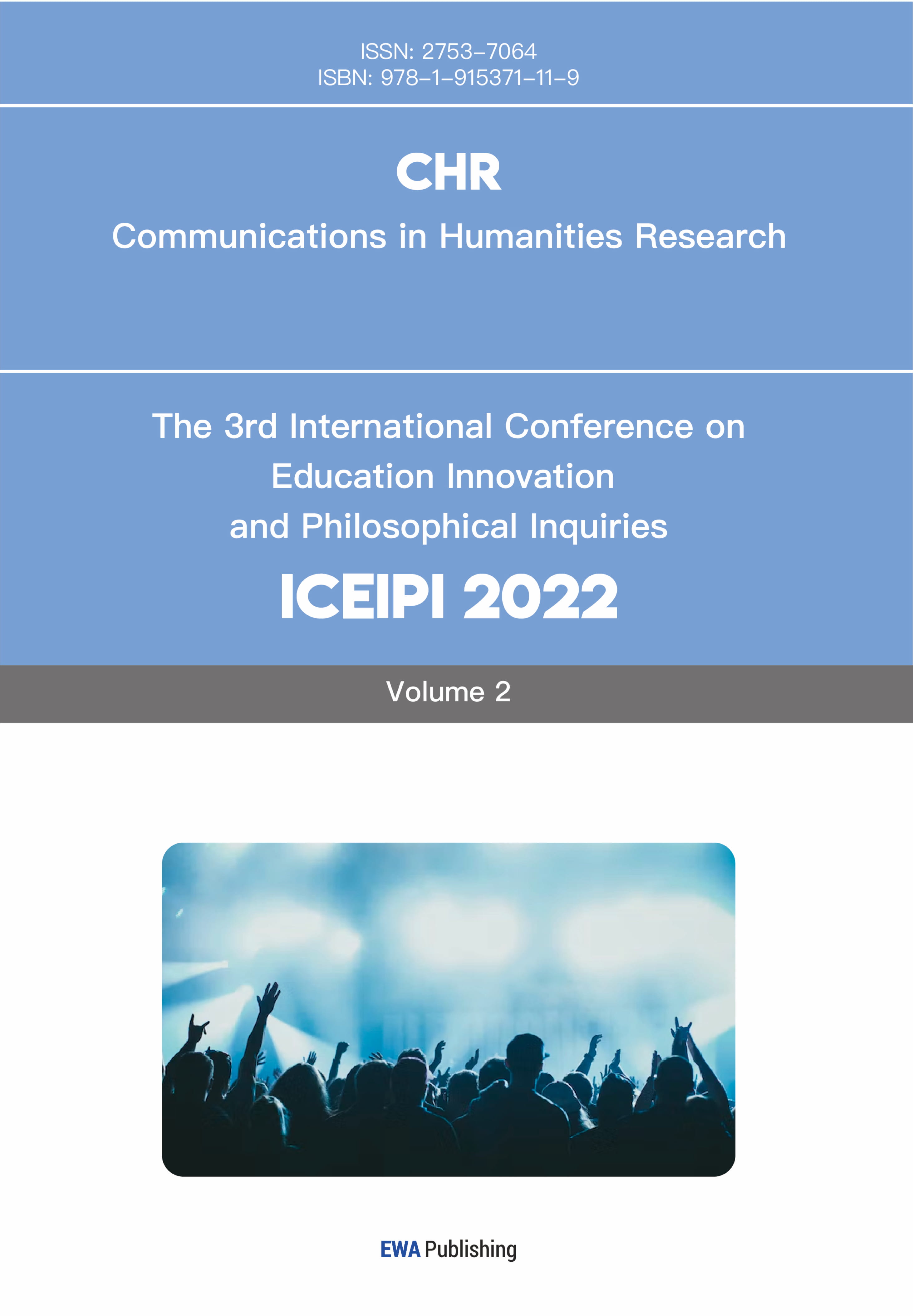References
[1]. Cole, Alan. (2009) Fathering Your Father: The Zen of Fabrication in Tang Buddhism. Univ of California Press.
[2]. Tai Xu. (1917) Gao tuzhong shu (The notice to lay people). In: Shun Yin. (Eds.), Collected Works of Tai Xu. Religious Culture Press, Beijing. pp. 104.
[3]. Zhang Jing. (1990) 'Guanyu jindai hua de gainian' (About the concept of Modernization). Socialogical Study, 14-25.
[4]. Black, C. E. (1968) "The Dynamics of Modernization. A Study in Comparative History." JSTOR.
[5]. Riggs, Fred W.J. (1997) Public Administration Review. "Modernity and Bureaucracy.", 47-53.
[6]. Donald E. MacInnis, Religion in ChinaToday: Policy and Practice (Maryknoll,N.Y.: Orbis Books,1989), 135–136.
[7]. Don A Pittman, Toward a modern Chinese Buddhism: Taixu's reforms. University of Hawaii Press, 2001.
[8]. Tai Xu. (1919) Fo cheng zongyao lun (The essence of Dharma). In: Shun Yin. (Eds.), Collected Works of Tai Xu. Religious Culture Press, Beijing. pp. 157-158.
[9]. Tai Xu. (1943) Renqun zhengzhi yu fojiao sengzhi (The governance of the people and the Buddhist sangha system). In: Shun Yin. (Eds.), Collected Works of Tai Xu. Religious Culture Press, Beijing. pp. 68-69.
[10]. Luo Tongbing. (2002) 'Tai Xu dui Zhongguo fojiao xiandai hua daolu de jueze' (Tai Xu's Choice of a Chinese Buddhist Modernist Movement). Bashu Publishing House, Sichuan.
[11]. Tai Xu. (1929) Wo zenyang panshe yiqie fofa (How I deem all Buddhist scripts). In: Shun Yin. (Eds.), Collected Works of Tai Xu. Religious Culture Press, Beijing. pp. 439.
[12]. Schlütter, M. (2008). How Zen became Zen: The dispute over enlightenment and the formation of Chan Buddhism in Song-Dynasty China (Vol. 22): University of Hawaii Press.
[13]. Pittman, D. A. (2001). Toward a modern Chinese Buddhism: Taixu's reforms: University of Hawaii Press.
Cite this article
Lin,X. (2023). Buddhist Revitalization and Tai Xu’s Buddhist Modernist Movement in China. Communications in Humanities Research,4,198-203.
Data availability
The datasets used and/or analyzed during the current study will be available from the authors upon reasonable request.
Disclaimer/Publisher's Note
The statements, opinions and data contained in all publications are solely those of the individual author(s) and contributor(s) and not of EWA Publishing and/or the editor(s). EWA Publishing and/or the editor(s) disclaim responsibility for any injury to people or property resulting from any ideas, methods, instructions or products referred to in the content.
About volume
Volume title: Proceedings of the International Conference on Interdisciplinary Humanities and Communication Studies (ICIHCS 2022), Part 2
© 2024 by the author(s). Licensee EWA Publishing, Oxford, UK. This article is an open access article distributed under the terms and
conditions of the Creative Commons Attribution (CC BY) license. Authors who
publish this series agree to the following terms:
1. Authors retain copyright and grant the series right of first publication with the work simultaneously licensed under a Creative Commons
Attribution License that allows others to share the work with an acknowledgment of the work's authorship and initial publication in this
series.
2. Authors are able to enter into separate, additional contractual arrangements for the non-exclusive distribution of the series's published
version of the work (e.g., post it to an institutional repository or publish it in a book), with an acknowledgment of its initial
publication in this series.
3. Authors are permitted and encouraged to post their work online (e.g., in institutional repositories or on their website) prior to and
during the submission process, as it can lead to productive exchanges, as well as earlier and greater citation of published work (See
Open access policy for details).
References
[1]. Cole, Alan. (2009) Fathering Your Father: The Zen of Fabrication in Tang Buddhism. Univ of California Press.
[2]. Tai Xu. (1917) Gao tuzhong shu (The notice to lay people). In: Shun Yin. (Eds.), Collected Works of Tai Xu. Religious Culture Press, Beijing. pp. 104.
[3]. Zhang Jing. (1990) 'Guanyu jindai hua de gainian' (About the concept of Modernization). Socialogical Study, 14-25.
[4]. Black, C. E. (1968) "The Dynamics of Modernization. A Study in Comparative History." JSTOR.
[5]. Riggs, Fred W.J. (1997) Public Administration Review. "Modernity and Bureaucracy.", 47-53.
[6]. Donald E. MacInnis, Religion in ChinaToday: Policy and Practice (Maryknoll,N.Y.: Orbis Books,1989), 135–136.
[7]. Don A Pittman, Toward a modern Chinese Buddhism: Taixu's reforms. University of Hawaii Press, 2001.
[8]. Tai Xu. (1919) Fo cheng zongyao lun (The essence of Dharma). In: Shun Yin. (Eds.), Collected Works of Tai Xu. Religious Culture Press, Beijing. pp. 157-158.
[9]. Tai Xu. (1943) Renqun zhengzhi yu fojiao sengzhi (The governance of the people and the Buddhist sangha system). In: Shun Yin. (Eds.), Collected Works of Tai Xu. Religious Culture Press, Beijing. pp. 68-69.
[10]. Luo Tongbing. (2002) 'Tai Xu dui Zhongguo fojiao xiandai hua daolu de jueze' (Tai Xu's Choice of a Chinese Buddhist Modernist Movement). Bashu Publishing House, Sichuan.
[11]. Tai Xu. (1929) Wo zenyang panshe yiqie fofa (How I deem all Buddhist scripts). In: Shun Yin. (Eds.), Collected Works of Tai Xu. Religious Culture Press, Beijing. pp. 439.
[12]. Schlütter, M. (2008). How Zen became Zen: The dispute over enlightenment and the formation of Chan Buddhism in Song-Dynasty China (Vol. 22): University of Hawaii Press.
[13]. Pittman, D. A. (2001). Toward a modern Chinese Buddhism: Taixu's reforms: University of Hawaii Press.









